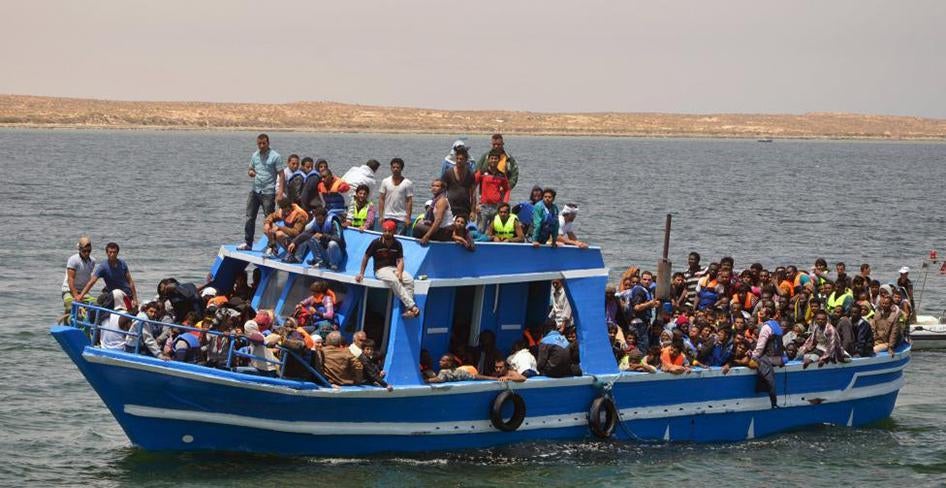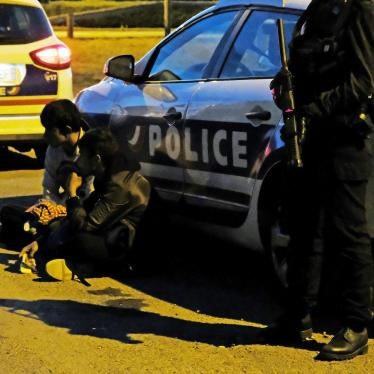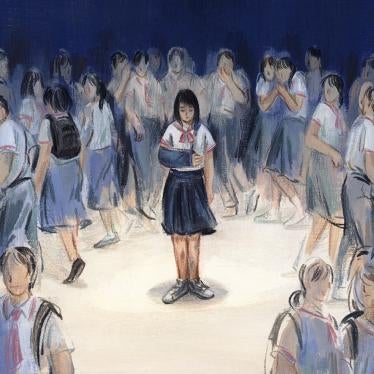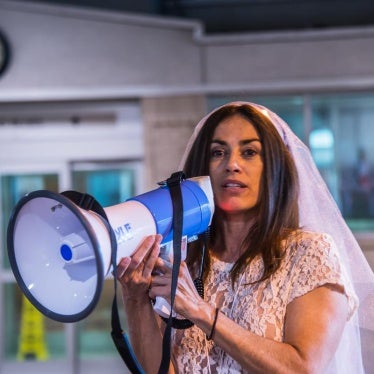Some recent media coverage of the global refugee and migrant crisis has used the terms “trafficking” and “smuggling” of migrants interchangeably.[1] However, in the context of movement of people the terms refer to different things. And most important, countries have distinct responsibilities toward people who have been trafficked and those who have resorted to smugglers to undertake a journey. This is intended as a guide for reporters and editors covering irregular migration to ensure that the articles — and headlines — accurately categorize both migrants and those who transport them— even if governments have at times obfuscated the categories.[2]
What is human smuggling?
International law defines smuggling of persons as procuring “the illegal entry of a person” into a country “in order to obtain, directly or indirectly, a financial or other material benefit.”[3] In other words, smugglers help people cross borders undetected in exchange for payment. The main legal instrument governing smuggling is the Protocol against the Smuggling of Migrants by Land, Sea and Air adopted in 2000.
And what is human trafficking?
International law defines trafficking of persons as “the recruitment, transportation, transfer, harbouring or receipt of persons,” by means of the threat or use of force or other forms of coercion, abduction, fraud, deception, or abuse of power “for the purpose of exploitation” with exploitation referring, “at a minimum” to “the exploitation of the prostitution of others or other forms of sexual exploitation, forced labour or services, slavery or practices similar to slavery, servitude or the removal of organs .”[4] In other words, traffickers move people from one place to another without their informed consent and exploit them along the way or at their final destination. The main legal instrument governing trafficking is the Protocol to Prevent, Suppress and Punish Trafficking in Persons, especially Women and Children also adopted in 2000.
What are the key differences between smuggling and trafficking people?
There are three fundamental differences: consent, exploitation, transnationality
- Consent. The smuggled person agrees to being moved from one place to another. Trafficking victims, on the other hand, have either not agreed to be moved or, if they have, have been deceived into agreeing by false promises, only to then face exploitation.
- Exploitation. Smuggling ends at the chosen destination where the smuggler and the smuggled person part ways. In contrast, traffickers exploit their victim at the final destination and/or during the journey.
- Transnationality. Smuggling always involves crossing international borders whereas trafficking occurs regardless of whether victims are taken to another country or moved within a country’s borders.
But don’t smugglers and traffickers profit from unlawfully transporting people?
Yes, in both trafficking and smuggling, criminal networks stand to profit from a business involving the transportation of human beings. However in the case of smugglers, their clients agree to pay and understand what the risks are, while in the case of trafficking, traffickers make their money from exploiting people who have not consented.
Can migrants be both smuggled and trafficked in the same journey?
Yes, some trafficked people might start their journey by agreeing to be smuggled into a country, only to then be deceived, coerced, or forced into an exploitative situation (for instance, being forced to work for very low wages or in debt bondage to pay for their transportation). Human Rights Watch has documented cases in which migrants paid smugglers to transport them, but were then transferred to traffickers, who detained and tortured them for ransom in exchange for release and for allowing them to continue their journey.[5]
So when smugglers abuse people they are transporting, is that not trafficking?
It can happen that the abuse some smugglers inflict on their clients is to exploit them in a way defined in international law, and then the smuggler effectively becomes a trafficker. But in most cases such abuse, including arbitrary violence for no particular reason, does not amount to “exploitation.” If the abuse is not for the purpose of exploitation and the victims then willingly continue their journey together with the smugglers, they should not be described as trafficking victims. In particular, although smugglers may expose their clients to grave danger and put their lives at risk by using unseaworthy or overcrowded boats, if asylum seekers and migrants are willing to take such risks such abuse does not constitute exploitation.
So if migrants consent to smuggling why should they receive help?
Most of those who resort to the services of smugglers despite all the risks are entitled to protection, not because of their mode of transport or the perils of their journey, but because of the factors that caused them to flee and their status as asylum seekers or refugees. Tens of thousands of asylum seekers fleeing persecution and other harm in their home countries use smugglers to reach countries of asylum by boat. Describing the criminals who move them as traffickers implies they are arriving against their will and avoids openly discussing why so many are fleeing their countries.
So who benefits from calling smugglers “traffickers?”
Incorrectly labelling “smugglers” as “traffickers” conveniently ignores reasons why asylum seekers and migrants chose to leave home—such as conflict, widespread human rights abuses, famine and economic destitution. It allows governments of countries they are trying to reach to imply that law enforcement is more important than ensuring asylum seekers can get protection and exercise their right to seek asylum and that actions such as destroying boats is a humanitarian act aimed at saving lives when in reality the objective of such policies is to prevent people from migrating irregularly across these countries’ borders.
So what about victims of actual trafficking?
International legal provisions encourage countries to assist and protect trafficking victims under the Protocol on Trafficking. This requires countries to provide for victims’ physical, psychological, and social needs and to consider allowing them to remain on their territory. Making clear distinctions between smuggling and trafficking in persons prevents undermining of these obligations.
[1] See, e.g., “Mediterranean migrant crisis: the Libyan human trafficker making $50,000 a week,” The Independent, June 10, 2015, http://www.independent.co.uk/news/world/africa/mediterranean-migrant-crisis-meet-the-libyan-human-trafficker-making-50000-a-week-10311681.html; “Hundreds of migrants rescued from people traffickers in Mediterranean,” The Guardian, June 6, 2015, http://www.theguardian.com/world/2015/jun/06/migrants-rescued-mediterranean-smugglers-libya; “People Traffickers Make Billions in Mediterranean,” Voice of America, May 6, 2015, http://www.voanews.com/content/people-traffickers-make-billions-in-mediterranean/2752513.html; “EU plans to combat trafficking 'moronic and delusional' say government advisers,” Newsweek, May 25, 2015, http://europe.newsweek.com/eu-trafficking-plans-moronic-delusional-say-government-advisers-327705.
[2] See comments by Italian Prime Minister Matteo Renzi ahead of the EU summit, April 22, 2015: http://www.bbc.com/news/world-europe-32420900. (“In the face of human trafficking it’s not a question of security or anti-terrorism.”); see also comments by Italian Foreign Minister Paolo Gentiloni calling for international support “to fight against these traffickers of human beings, this new slavery of the 21st century,” April 20, 2015, http://www.wsj.com/articles/rich-smuggling-trade-fuels-deadly-migration-across-mediterranean-1429576356.
[3] Protocol Against the Smuggling of Migrants by Land, Sea and Air, Article 3.
[4] Protocol to Prevent, Suppress and Punish Trafficking in Persons, Especially Women and Children, Article 3.
[5] Human Rights Watch, Pushed Back, Pushed Around, Italy’s Forced return of boat Migrants and Asylum Seekers, Libya’ Mistreatment of Migrants and Asylum Seekers, September 2009, pp. 55-57. Human Rights Watch, “I Wanted to Lie Down and Die” Trafficking and Torture of Eritrean in Sudan and Egypt, February 2014, pp, I, II, III, 31-41.









